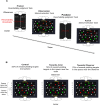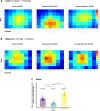Paying attention to the outcome of others' actions has dissociated effects on observer's peripersonal space representation and exploitation
- PMID: 37349516
- PMCID: PMC10287734
- DOI: 10.1038/s41598-023-37189-8
Paying attention to the outcome of others' actions has dissociated effects on observer's peripersonal space representation and exploitation
Abstract
The representation of peripersonal space (PPS representation) and the selection of motor actions within it (PPS exploitation) are influenced by action outcomes and reward prospects. The present study tested whether observing the outcome of others' actions altered the observer's PPS representation and exploitation. Participants (observers) performed a reachability-judgement task (assessing PPS representation) before and after having observed a confederate (actors) performing a stimuli-selection task on a touch-screen table. In the stimuli-selection task, the stimuli selected could either yield a reward or not, but the probability to select a reward-yielding stimulus was biased in space, being either 50%, 25% or 75% in the actor's proximal or distal space. After the observation phase, participants performed the stimuli-selection task (assessing PPS exploitation), but with no spatial bias in the distribution of reward-yielding stimuli. Results revealed an effect of actors' actions outcome on observers' PPS representation, which changed according to the distribution of reward-yielding stimuli in the actors' proximal and distal spaces. No significant effect of actors' actions outcome was found on observers' PPS exploitation. As a whole, the results suggest dissociated effects of observing the outcome of others' actions on PPS representation and exploitation.
© 2023. The Author(s).
Conflict of interest statement
The authors declare no competing interests.
Figures





References
Publication types
MeSH terms
LinkOut - more resources
Full Text Sources
Research Materials

